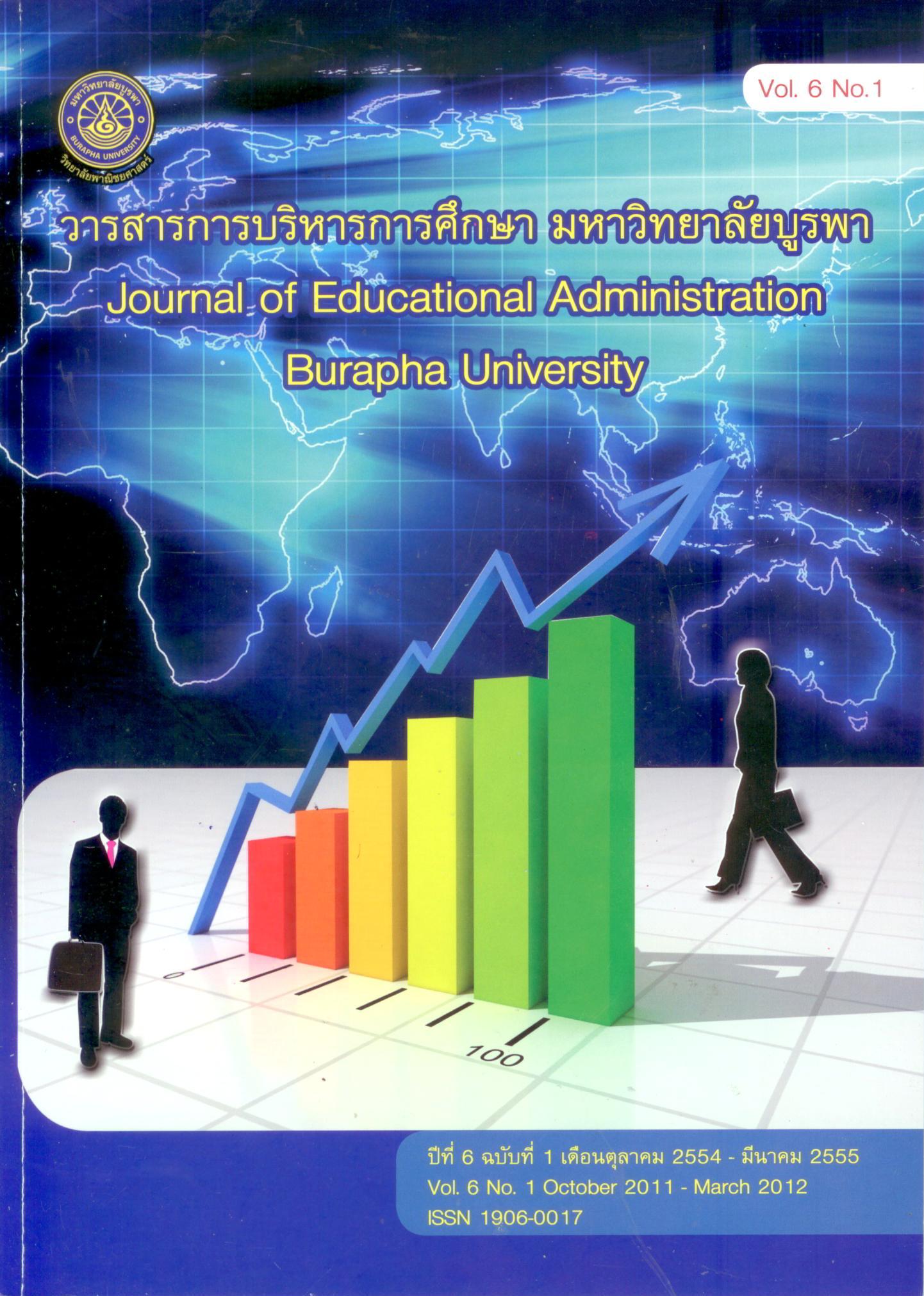ยุทธศาสตร์การบริหารโรงเรียนมัธยมศึกษาขนาดใหญ่พิเศษยอดนิยม: กรณีศึกษาโรงเรียนแห่งหนึ่งในกรุงเทพมหานคร
Keywords:
ยุทธศาสตร์การบริหารโรงเรียนมัธยมศึกษาขนาดใหญ่พิเศษยอดนิยม, โรงเรียนในกรุงเทพมหานคร, Administrative strategies, Popular large-sized secondary school, A schoolin Bangkok MetropolisAbstract
บทคัดย่อ
การวิจัยครั้งนี้มีวัตถุประสงค์เพื่อศึกษายุทธศาสตร์การบริหารโรงเรียนมัธยมศึกษาขนาดใหญ่พิเศษยอดนิยม: กรณีศึกษาโรงเรียนแห่งหนึ่งในกรุงเทพมหานครโดยใช้เทคนิคการวิจัยเชิงคุณภาพโดยศึกษาประวัติความเป็นมา ยุทธศาสตร์ และการบริหารยุทธศาสตร์ การจัดองค์การ วัฒนธรรมองค์การและศึกษาสภาพปัญหาในการบริหารและแนวทางแก้ปัญหาของโรงเรียน เลือกกลุ่มตัวอย่างแบบเจาะจง ได้แก่ อดีตผู้บริหารโรงเรียน ผู้บริหารโรงเรียนปัจจุบัน รองผู้อำนวยการโรงเรียน หัวหน้ากลุ่มสาระการเรียนรู้ คณะกรรมการสถานศึกษาขั้นพื้นฐานและตัวแทนเครือข่ายผู้ปกครองนักเรียน เก็บข้อมูลโดยใช้วิธีการศึกษาข้อมูลจากเอกสาร การสัมภาษณ์ระดับลึก (In-depth Interview) การจัดกลุ่มสนทนา(Focus Group Discussion) และวิธีการสังเกตและการจดบันทึก (Observation And Field-Note) วิเคราะห์ข้อมูลแบบสร้างข้อสรุปโดยวิธีการวิเคราะห์เนื้อหา (Content Analysis) วิเคราะห์เชิงวัฒนธรรม (Cultural Analysis) วิเคราะห์เชิงเปรียบเทียบระหว่างกลุ่ม (Analytic Comparison) วิเคราะห์ภาพสำเร็จ (Successive Approximation) ตรวจสอบข้อมูลโดยใช้วิธีการตรวจสอบแบบสามเส้าด้านวิธีรวบรวมข้อมูล (Methodological Triangulation) ตรวจสอบแบบสามเส้าด้านผู้วิจัย (InvestigatorTriangulation) แล้วนำกลับไปให้ผู้ให้ข้อมูลอ่านหรือกลับไปถามผู้ให้ข้อมูลซ้ำอีก (Reflecting)
ผลการวิจัยพบว่า
1. โรงเรียนกรณีศึกษามีประวัติและความเป็นมาแบ่งได้ 3 ยุค คือ ยุคก่อตั้ง ยุคพัฒนาและ ยุคปัจจุบัน
2. โรงเรียนกรณีศึกษามียุทธศาสตร์การบริหาร 7 ยุทธศาสตร์คือ 1) การพัฒนาองค์การและบุคลากร 2) การปฏิรูปการจัดการเรียนรู้ที่เน้นผู้เรียนเป็นสำคัญ 3) การส่งเสริมและพัฒนาการใช้เทคโนโลยีทางการศึกษา แหล่งเรียนรู้และระบบเครือข่ายสารสนเทศ 4) การสร้างคุณธรรม จริยธรรมแก่นักเรียนและครู 5) พัฒนาระบบบริหารจัดการแบบมีส่วนร่วมในทุกเครือข่าย 6) การนำนโยบายสู่การปฏิบัติและ 7) ยุทธศาสตร์โรงเรียนเล็กในโรงเรียนใหญ่ และพบว่าโรงเรียนกรณีศึกษา ได้บริหารยุทธศาสตร์โดยใช้ 4 หลัก คือ 1) หลักการกระจายอำนาจ 2) หลักการมีส่วนร่วม 3) หลักธรรมาภิบาลและ 4) ใช้หลักการประชาสัมพันธ์ที่ดี
3. โรงเรียนกรณีศึกษากำหนดโครงสร้างการบริหารเป็น 4 กลุ่ม แต่ละกลุ่มงานมีรองผู้อำนวยการโรงเรียน 1 คน และผู้ช่วยผู้อำนวยการ 1 คน ทำหน้าที่ในการกำกับดูแลติดตามงานแต่ละกลุ่มงานมีการกำหนดภาระงาน ขั้นตอนการปฏิบัติงาน และผู้รับผิดชอบชัดเจน นอกจากนั้นยังมีคณะกรรมการสถานศึกษาขั้นพื้นฐาน สมาคมศิษย์เก่า สมาคมผู้ปกครองและครู มูลนิธิ และเครือข่ายผู้ปกครองส่งเสริมและสนับสนุนกิจการของโรงเรียน
4. โรงเรียนกรณีศึกษามีวัฒนธรรมองค์การ 4 ประการคือ 1) วัฒนธรรมการมีส่วนร่วม 2) วัฒนธรรมการทำงานเป็นทีม 3) วัฒนธรรมที่เป็นองค์การแห่งการเรียนรู้ 4) วัฒนธรรมการทำงานแบบพี่น้อง
5. โรงเรียนกรณีศึกษามีปัญหาในการบริหารและแนวทางแก้ปัญหาของโรงเรียนดังนี้คือ 1) จำนวนนักเรียนที่มากเกินไป แก้ปัญหาโดยบริหารจัดการแบบโรงเรียนเล็กในโรงเรียนใหญ่และมีการกระจายอำนาจการบริหาร 2) บุคลากรไม่เพียงพอ แก้ปัญหาโดยการจ้างครูที่มีความเชี่ยวชาญในการสอนทั้งชาวไทยและชาวต่างประเทศ 3) งบประมาณไม่เพียงพอ แก้ปัญหาโดยการระดมทรัพยากรจากทุกภาคส่วน 4) ความคิดเห็นที่แตกต่างกันของผู้ปกครอง นักเรียน และครู แก้ปัญหาโดยชี้แจง ประชาสัมพันธ์ให้ทุกส่วนเข้าใจตรงกัน
คำสำคัญ : ยุทธศาสตร์การบริหารโรงเรียนมัธยมศึกษาขนาดใหญ่พิเศษยอดนิยม, โรงเรียนในกรุงเทพมหานคร
ABSTRACT
This study aimed to investigate the administrative strategies of popular specialitylarge-sized secondary school by focusing on one school in Bangkok Metropolis by utilizingqualitative research methods. The history of school, the strategies and the strategy administration,organization, organizational cultures, and the state of problems in administrationand solutions were examined. The purposive sampling groups were selected, includedformer school directors, present directors, vice directors, heads of learning strands, thecommission of basic education, and parent network representatives. Data collection was carried out by studying from documentary sources, in-depth interview, focus group discussion,observation, and field-note. The data analysis was conducted through content analysis,cultural analysis, analytical comparison, and successive approximation. The accuracyand reliability of the data were examined by the methodological triangulation, investigatortriangulation, and reflecting methods.
The findings of the study were as the following:
1. The history of the school was divided into 3 periods: the foundational period,the developing period, and the present period
2. Seven administrative strategies were found to be utilized as follows: 1) developmentof organization and personnel, 2) learning management reform focused on studentcentered, 3) promotion and development of educational technology, learning centers andinformation network system, 4) cultivation of moral and ethics to students and teachers, 5)development of participatory administration in every single network, 6) policy implementation,and 7) employment of administration strategy of small-sized school within large-sizedschool. It was found that the investigated school utilized 4 principles of administrativestrategy: 1) decentralization, 2) participation, 3) good governance and 4) public relations.
3. The sampled school divided the administrative structure into 4 groups. Eachgroup has one vice director and one assistant director to be responsible for monitoringand follow up the tasks assigned. Job assignments, work performance processes, andresponsible bodies were apparently formed. Moreover, the commission of basic education,alumni, parents and teachers club, foundations and parent network to promote schoolactivities were also participated.
4. The school was found to have four organizational cultures: 1) participative culture,2) team-work culture, 3) learning organization culture and 4) brotherhood and sister hoodworking culture.
5. The problems and solutions found in its administration involved the following: 1)excessive number of students, the solution was done by employment of administrationstrategy of small-sized school within large-sized school and decentralization; 2) insufficiencyof personnel, the solution was performed by hiring qualified native and non-native teachers;3) insufficiency of budget, the solution was done through pooling of resources fromall partners, and 4) the differences of parents, students, and teachers, the solution wasdone by addressing of public relations for mutual understanding to the involved bodies.
KEYWORDS : Administrative strategies, Popular large-sized secondary school, A schoolin Bangkok Metropolis


